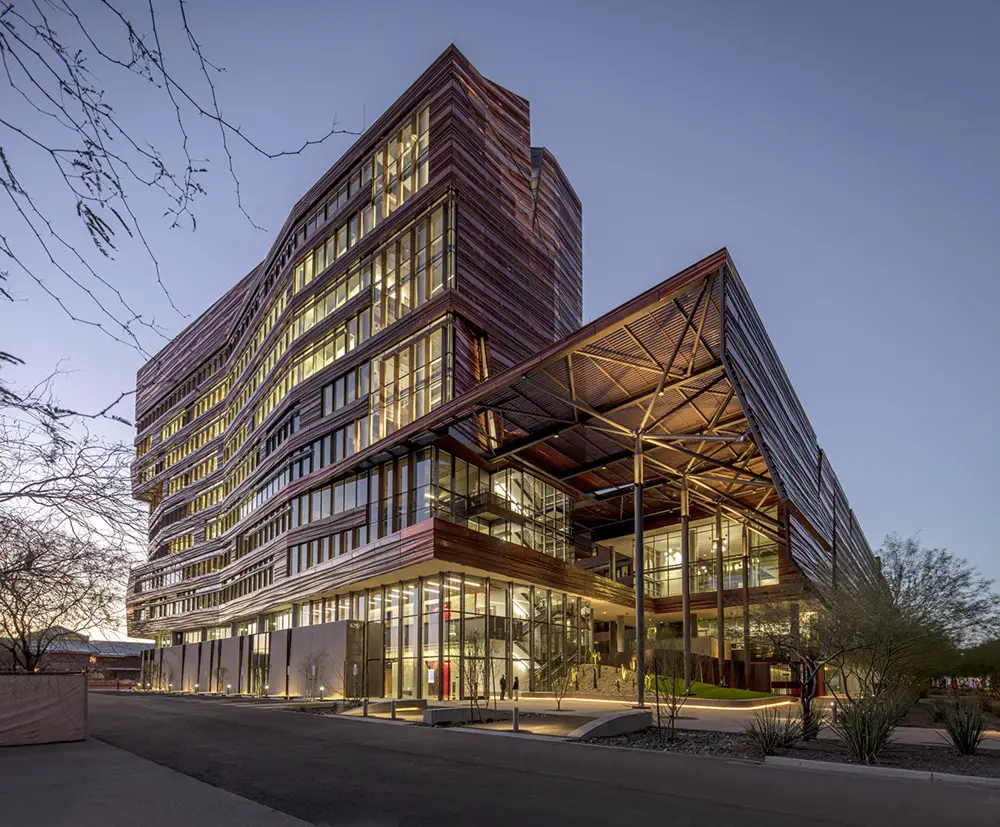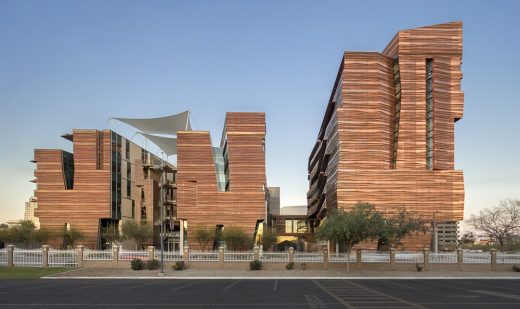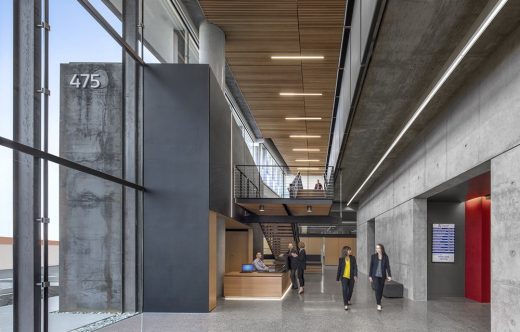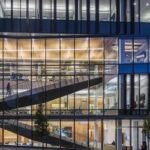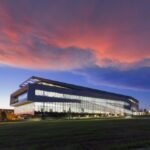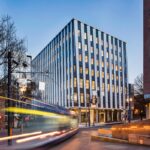BSPB Arizona, Biomedical Sciences Partnership Building Phoenix, University of Arizona Biomedical Campus design
Biomedical Sciences Partnership Building, University of Arizona
Phoenix Biomedical Campus Facility design by CO Architects, USA.
Jun 23, 2018
Design: CO Architects with Ayers Saint Gross
Location: Phoenix, Arizona, USA
Biomedical Sciences Partnership Building (BSPB) at the University of Arizona Phoenix Biomedical Campus
The design of the 245,000-GSF Biomedical Sciences Partnership Building (BSPB) at the University of Arizona Phoenix Biomedical Campus is inspired by Arizona’s iconic, majestic mountains and canyons.
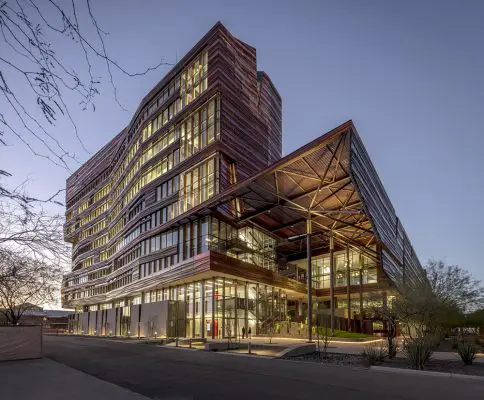
photos courtesy of The Chicago Athenaeum
Biomedical Sciences Partnership Building at the University of Arizona Phoenix
Completed in January 2017 and conceived as a singular complex alongside the Health Science Education Building (2012), the BSPB honors the region’s urban desert vernacular and geology established by its predecessor. But it presents a different physical interpretation of the tall, cleft, desert rock formations through a pronounced series of setbacks and projections.
Inspired by the deep recesses of desert cliff dwellings, BSPB’s sloping, shifting, self-shaded south façade rises 10 floors above the vegetated canyon wash, resembling desert escarpments.
Clad in folded copper panels, its striated texture is achieved by manipulating recycled copper, forming a beautiful and innovative cladding system that is most suitable for a desert climate. A sunscreen of sorts, the cladding system utilizes nearly 4,800 formed, bent and perforated copper panels to reflect light and cast shadows that reflect the striated canyon walls.
Not only is the copper cladding the BSPB’s signature aesthetic feature, it also serves to mitigate the extreme temperature differences between the exterior and interior. Adapting rainscreen technology, the building’s design team took a system typically used in the northwestern US and created a way to utilize copper cladding as a sunscreen, mitigating the excessive heat.
This fully integrated system of copper panels, a 2-inch air space, rigid insulation and a waterproofing membrane work together to absorb the radiant heat, and allow it to vent out through the building’s top. While the copper will likely remain a brownish hue in this arid climate, its color will change and become variegated over time, further connecting it visually to the surrounding mountains. The copper cladding is made up of 90-95 percent recycled material in order to help achieve its LEED Silver certification.
The desert can be relentless and harsh, and the BSPB needed to adapt to this difficult environment. Thus, the design was shaped by the Arizona climate and the goal of reducing energy consumption. Cantilevered floors extending increasingly outward at the top of the building shade the lower levels. Windows are mostly limited to the north and south sides of the building to control daylight and conserve energy.
Deep, glazed incisions allow light to flow into the building from the north and south where it can be controlled. Shading devices of varying shapes, configured to their specific solar orientation, protect glazing from direct solar radiation in the summer, while admitting winter sun.
This contributes to the overall energy savings for the building by reducing the cooling and heating costs. In addition to the copper paneling, sustainable features include passive orientation, cascade air supply system, chilled beams in labs and open offices, and LED lighting.
BSPB is organized to encourage collegiality, collaboration, and customization. Programmed and planned before the occupants had been finalized, the building is designed with a general framework of labs, support spaces, and offices, with the intent of creating an adaptable plan and utility distribution backbone that would be easy to modify for different types of research.
Open offices at the north perimeter take advantage of daylight and views, and are visually connected to the labs currently supporting neurological, cardiovascular, cancer, genomic, and nano-bioscience research. Highly flexible lab support spaces are designed as “wet garages” and are arranged next to the windows on the south side. Mechanical equipment is housed on the windowless east and west ends rather than on the rooftop, protecting the occupants from the intense Phoenix sun.
At the northwest corner, researchers and industry representatives meet on laboratory floors to exchange ideas in glass-enclosed, two-story spaces designed with meeting rooms, lounges, and kitchenettes. A sheltering entrance porch on west side of the building faces the central campus green.
Extending northward from the portion of the building containing lobbies, café, library, and meeting spaces—nicknamed “The Mixing Bar”—the entrance forms a sun-shaded gathering space similar to an outside lobby. A linear gallery connects the lobby to the courtyard, and acts as a pre-function space for a multi-purpose meeting center accommodating groups ranging from 50 to 200.
Biomedical Sciences Partnership Building at the University of Arizona Phoenix – Building Information
Architects: CO Architects
Associate Architects: Ayers Saint Gross
Client: Client: University of Arizona
General Contractor: DPR Construction, Inc./Sundt Construction, Inc., Joint Venture
Biomedical Sciences Partnership Building at the University of Arizona Phoenix images / information from The Chicago Athenaeum, 150618
Biomedical Sciences Partnership Building at the University of Arizona is one of over 100 shortlisted buildings to win at the prestigious 2018 American Architecture Awards:
American Architecture Awards 2018
Location: University of Arizona, Phoenix, Arizona, USA
Arizona Buildings
New Arizona Architecture
Contemporary Arizona Buildings
Levin Residence
Design: Ibarra Rosano Design Architects
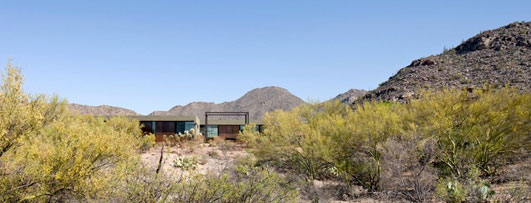
photo : Bill Timmerman
Levin Residence
Home 901, Sabino Springs, Tucson
Design: Kevin B. Howard Architects
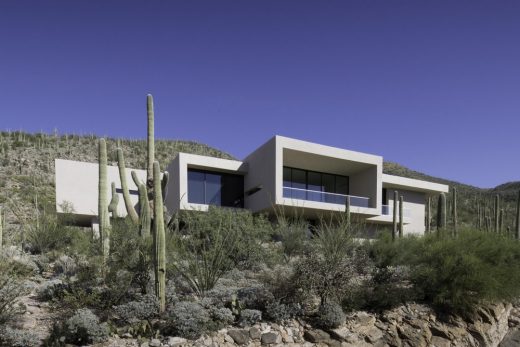
photograph : Matt Winquist and Robin Stancliff
Sabino Springs Home
A Modern Mission Style House along the Arizona Canal, Phoenix
Architect: The Ranch Mine
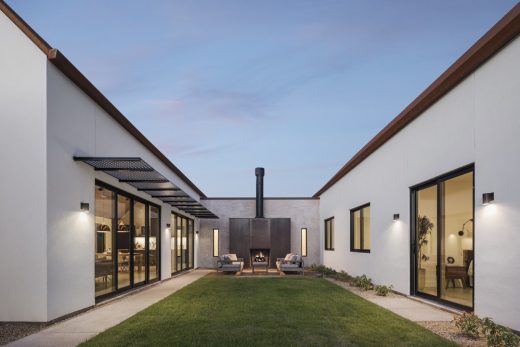
photograph : Roehner + Ryan
Canal House in Arizona
Barrio Historico House, Tucson
Architect: HK Associates
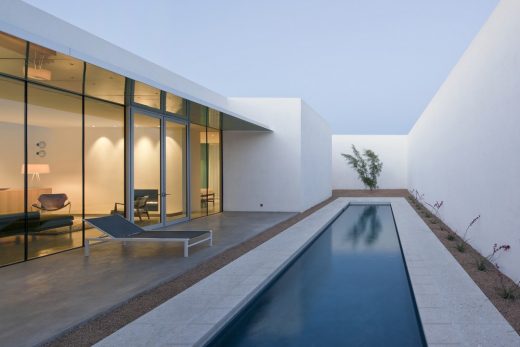
photograph : Bill Timmerman
Contemporary Tucson Home
Casa Caldera, Patagonia, San Rafael Valley
Architect: DUST
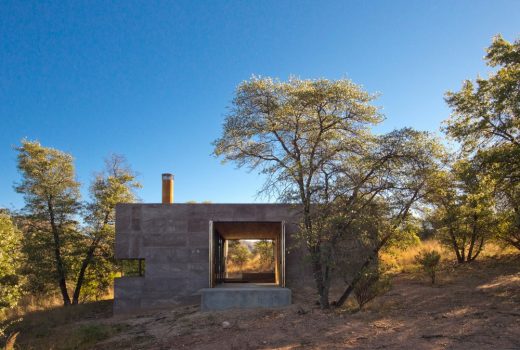
photograph : Cade Hayes
New Residence in Patagonia
American Architecture Designs
American Architectural Designs – recent selection from e-architect:
Buildings / photos for the Biomedical Sciences Partnership Building at the University of Arizona Phoenix design by CO Architects, USA. page welcome
Website: Biomedical Sciences Partnership Building at the University of Arizona, USA

